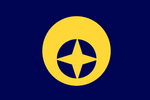Canterra

|
Canterra Kuunghwa Ankwoengok (Canterran) Capital: Nautecove
Population: 20,327,914 (2024) Motto: One Nation, One Goal Anthem: March of The Canterrans |
Loading map... |
The Republic of Ankwoen (Canterran: Kuunghwa Ankwoenkog), known mononymously as Canterra, is a country located in the Lantian Peninsula, a peninsula of East Uletha. Canterra consists of fourteen states further split into (YY) counties; it borders Zdansk and Lantia to the north, and Westway and Fiorentia (a overseas territory of Merganien) with a coastline of the Gulf of Volta and the Gulf of Orinoco. The official language is Ingerish and Ankwoyeina, with 34 more smaller historical dialects.
History
Etymology
Prehistory and history
Scientists believe that Canterra was first inhabited at around 40,000 BC, as stone artifacts in Parlenage, Nordenkans and Norrsein have been recorded to have a average age of 34,000 BC. Homo erectus Lenthialis (Lenthials) have been found in caves in Torlonza, Embrosinet and Cuinnhodekoon State. These people may have been related with Izaki hunters, however, we know that these people travelled by boat, from the modern day Yenkaido Province to the western coast of Westway and Canterra. When they got to Canterra, they had developed a different dialect, similar to the Aynu Itak dialects of northeast Izaland, which at that time, was called Aynu Kitay (People of the Mountains). At this time, there was a fertile valley between the (OOO) hill range and the (△△△) hill range, known as the Showas Valley, now known as the Navoyeun Basin. From 10,000 AD to around year 0, a major kingdom developed in the east coast of modern-day Canterra, known as the Yohyaken Kingdom, based in the old capital of Myettkom (now Canton Illenfleor, Liisundiene)
Izaki Influence
Around 90 AD, the Kingdom of Sopeke successfully invaded Canterra, and called this territory "Kuusamo", which meant "Nine Mountains"(representing the nine mountains on the outcoast of a small town named Eiha also known as modern-day Nautecove), and built a new capital in the Navoyeun Basin, known as Kutsebelo. During this time, the Izaki set up a monarchy system that consisted of 10 kings over a time period of 92 years. The Izaki rule stopped from 180 - 190 AD, when the Canterrans won the Battle of Kuretsel, where Izaki troops were forced to flee to Nantaa (current day Westway). After this, natives declared independence, and created Kwoendae.
Ingerish Lantia
In 821, the Ingerish Empire started conquering the Lantian Peninsula, starting with modern-day Zdansk, then the northern half of the peninsula, then Canterra. The Ingerish had started invading from modern day Garthram, Lantia and north of the Wexdale River, which led to the Ingerish fully conquering Canterra in 827, and the whole Lantian Peninsula. During this time, Canterra was called Kausania, after "Kaosan", translating literally to high mountains. During the Ingerish Lantian rule, the Ingerish had taken most of the land away from native farmers, and sold most of the resources to other major countries. This went on for the rest of Ingerish Lantia's rule, until the year 1623.
Independence
In the year 1623, a man called Reyes Maccarimi became ruler of Dasgrundia. As Maccarimi was a revolutionary, from 1623 to early 1624, Maccarimi replaced all of the Ingerish officials with Canterran politicians, and secretly moved major government offices to a suburb of Nautecove, called Aigelle. Then, in July 1624, Maccarimi ran a vote for independence in 2 cities: Nautecove and Roscal along with votes in 189 towns and villages throughout Canterra. The result was a 92% vote for independence. On August 26th, 1624, Reyes Maccarimi declared independence from the Ingerish and called the new republic "Canterra", after the Canterran name "Candeuss", meaning mighty and the Castellanese suffix -terra, for land. Canterra was the first state to gain independence from Ingerish Lantia, and unknown to the Ingerish, the rest would gain independence soon after. The Ingerish started a war, but the war was fairly short in Canterra, and the Battle of Ebereinet marked the end of this war, in 1636.
Post-independence
After the war, the Ingerish immediately stopped funding for Canterra, and Canterra went into a state of famine in poverty. However, with the rule of Tsogetau Rellington, Canterra's 3rd president, the famine ended (from 1637-1639), and immediately after, there was a minor population boom. The population of Canterra went from 700,000 to 2,000,000 people, and Canterra had a economic boom. Canterra started exporting fruits, and metal products.
In the 18th and 19th century,






